Business Law Report: Analysis of Jack Smith vs. Dandenong Council
VerifiedAdded on 2023/02/01
|6
|1426
|45
Report
AI Summary
This report analyzes a business law case where Jack Smith is suing the Dandenong Council for negligence, specifically concerning economic loss. The issue revolves around whether the council's actions, related to a road widening project, caused Smith financial harm. The report delves into the legal principles of pure economic loss, the duty of care, and negligent misstatements, referencing key cases such as Hedley Byrne & Co Ltd v Heller & Partners Ltd, Spartan Steel & Alloys Ltd v Martin, and Shaddock & Associates Pty Ltd and Another v Parramatta City Council. The application section argues Smith's potential claims, including a fiduciary relationship and negligent misstatement, and the council's defenses. The conclusion suggests that Smith may not be able to recover damages because the loss is deemed pure economic loss. The report includes a comprehensive list of references.
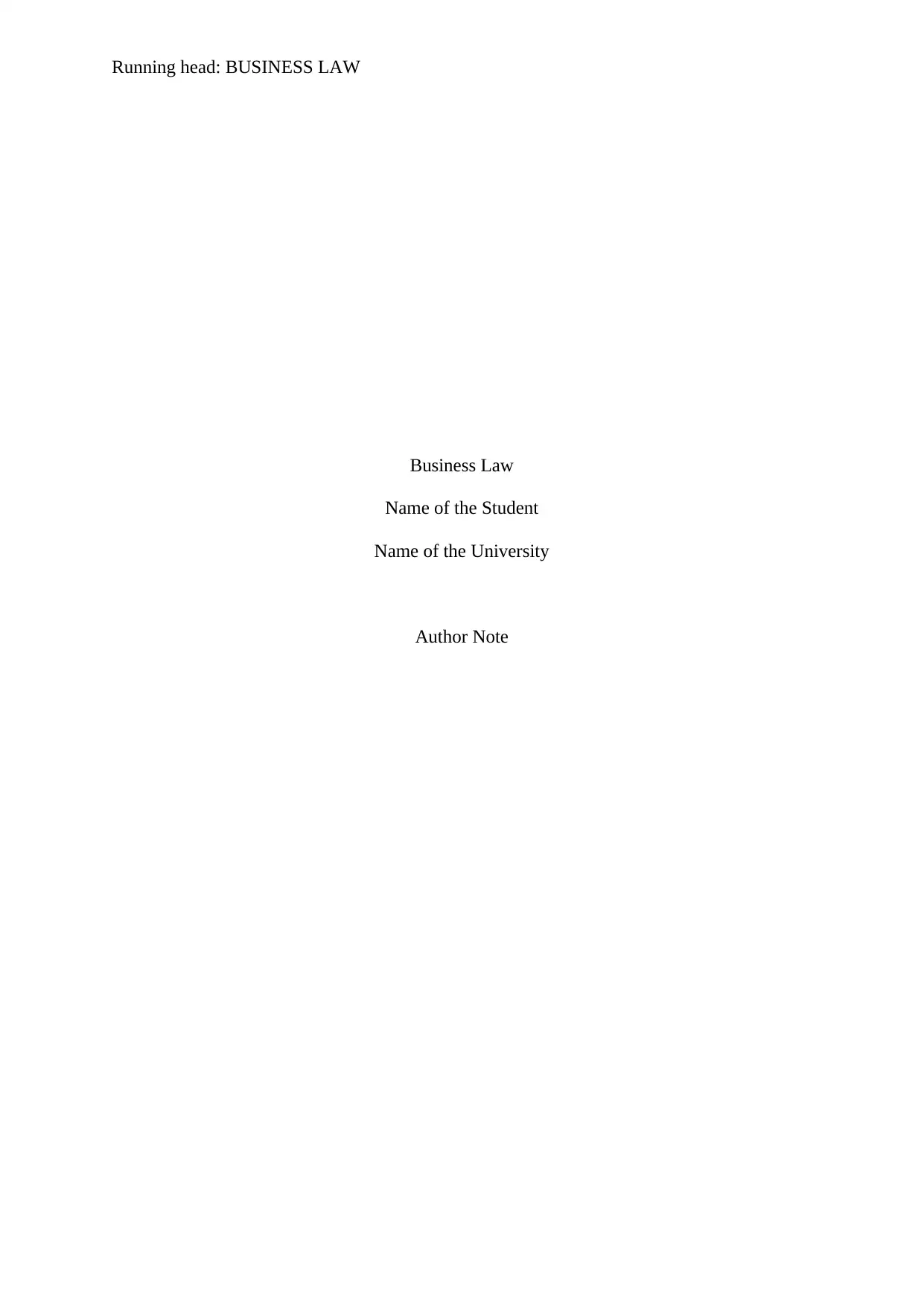
Running head: BUSINESS LAW
Business Law
Name of the Student
Name of the University
Author Note
Business Law
Name of the Student
Name of the University
Author Note
Paraphrase This Document
Need a fresh take? Get an instant paraphrase of this document with our AI Paraphraser
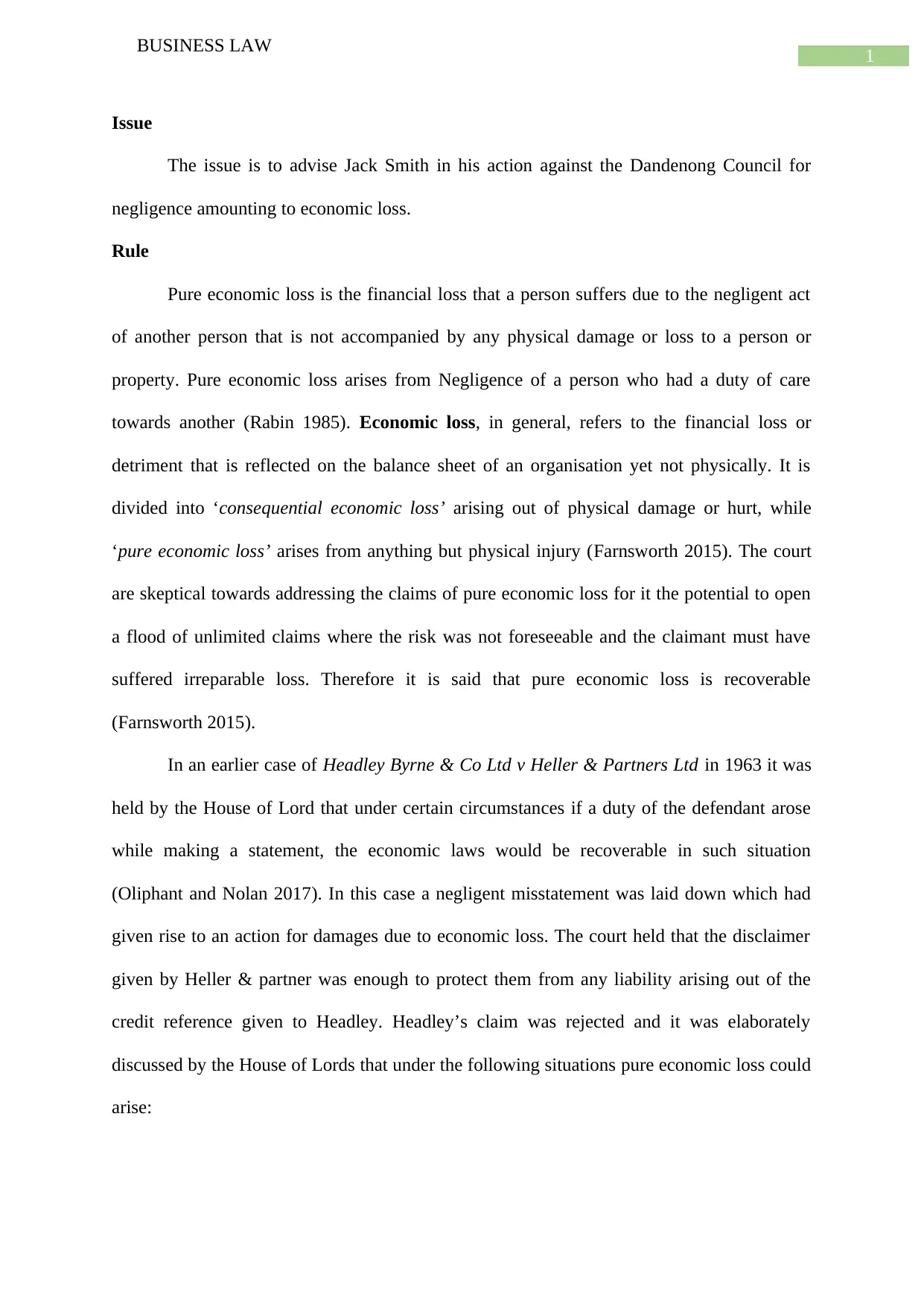
1
BUSINESS LAW
Issue
The issue is to advise Jack Smith in his action against the Dandenong Council for
negligence amounting to economic loss.
Rule
Pure economic loss is the financial loss that a person suffers due to the negligent act
of another person that is not accompanied by any physical damage or loss to a person or
property. Pure economic loss arises from Negligence of a person who had a duty of care
towards another (Rabin 1985). Economic loss, in general, refers to the financial loss or
detriment that is reflected on the balance sheet of an organisation yet not physically. It is
divided into ‘consequential economic loss’ arising out of physical damage or hurt, while
‘pure economic loss’ arises from anything but physical injury (Farnsworth 2015). The court
are skeptical towards addressing the claims of pure economic loss for it the potential to open
a flood of unlimited claims where the risk was not foreseeable and the claimant must have
suffered irreparable loss. Therefore it is said that pure economic loss is recoverable
(Farnsworth 2015).
In an earlier case of Headley Byrne & Co Ltd v Heller & Partners Ltd in 1963 it was
held by the House of Lord that under certain circumstances if a duty of the defendant arose
while making a statement, the economic laws would be recoverable in such situation
(Oliphant and Nolan 2017). In this case a negligent misstatement was laid down which had
given rise to an action for damages due to economic loss. The court held that the disclaimer
given by Heller & partner was enough to protect them from any liability arising out of the
credit reference given to Headley. Headley’s claim was rejected and it was elaborately
discussed by the House of Lords that under the following situations pure economic loss could
arise:
BUSINESS LAW
Issue
The issue is to advise Jack Smith in his action against the Dandenong Council for
negligence amounting to economic loss.
Rule
Pure economic loss is the financial loss that a person suffers due to the negligent act
of another person that is not accompanied by any physical damage or loss to a person or
property. Pure economic loss arises from Negligence of a person who had a duty of care
towards another (Rabin 1985). Economic loss, in general, refers to the financial loss or
detriment that is reflected on the balance sheet of an organisation yet not physically. It is
divided into ‘consequential economic loss’ arising out of physical damage or hurt, while
‘pure economic loss’ arises from anything but physical injury (Farnsworth 2015). The court
are skeptical towards addressing the claims of pure economic loss for it the potential to open
a flood of unlimited claims where the risk was not foreseeable and the claimant must have
suffered irreparable loss. Therefore it is said that pure economic loss is recoverable
(Farnsworth 2015).
In an earlier case of Headley Byrne & Co Ltd v Heller & Partners Ltd in 1963 it was
held by the House of Lord that under certain circumstances if a duty of the defendant arose
while making a statement, the economic laws would be recoverable in such situation
(Oliphant and Nolan 2017). In this case a negligent misstatement was laid down which had
given rise to an action for damages due to economic loss. The court held that the disclaimer
given by Heller & partner was enough to protect them from any liability arising out of the
credit reference given to Headley. Headley’s claim was rejected and it was elaborately
discussed by the House of Lords that under the following situations pure economic loss could
arise:
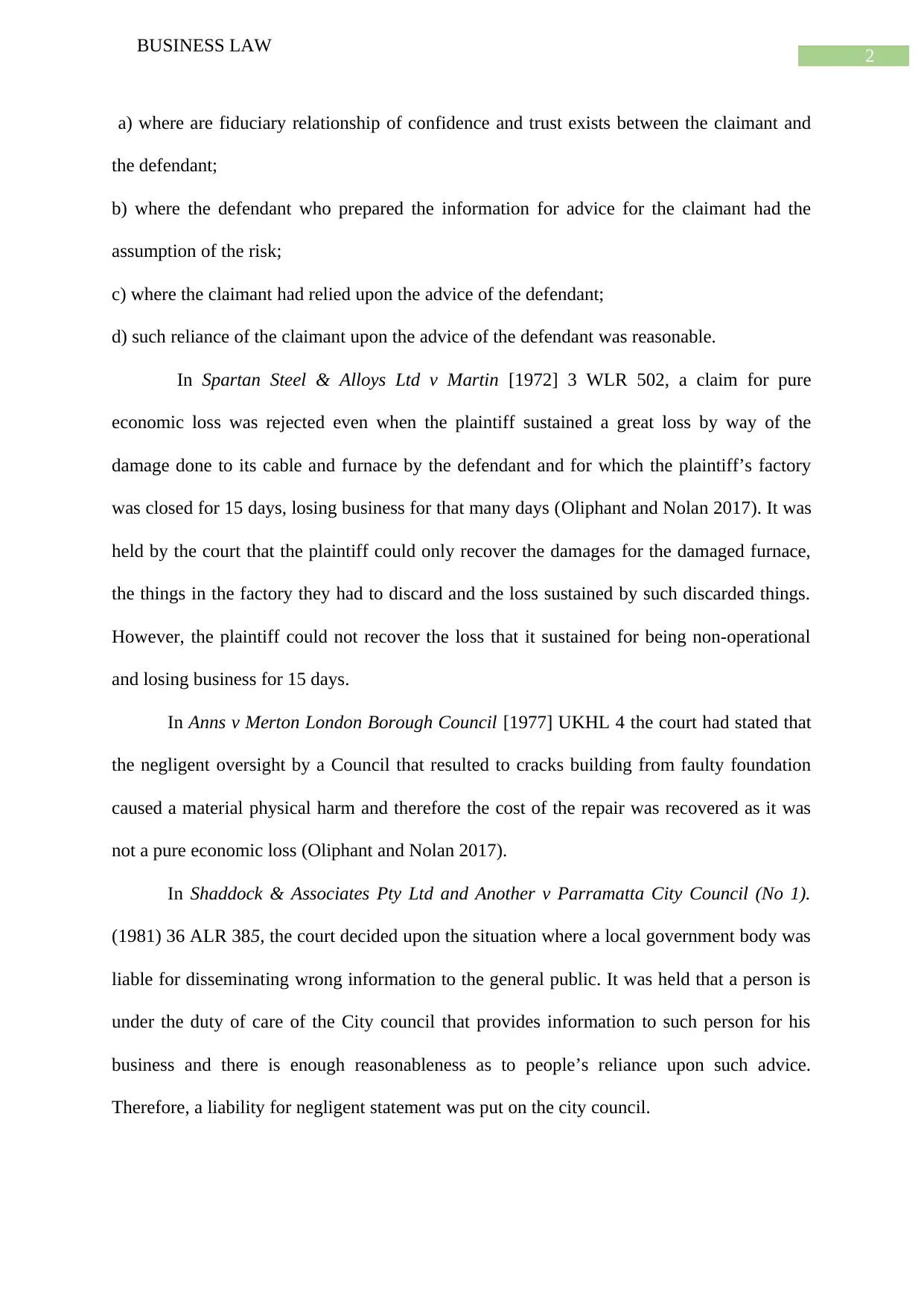
2
BUSINESS LAW
a) where are fiduciary relationship of confidence and trust exists between the claimant and
the defendant;
b) where the defendant who prepared the information for advice for the claimant had the
assumption of the risk;
c) where the claimant had relied upon the advice of the defendant;
d) such reliance of the claimant upon the advice of the defendant was reasonable.
In Spartan Steel & Alloys Ltd v Martin [1972] 3 WLR 502, a claim for pure
economic loss was rejected even when the plaintiff sustained a great loss by way of the
damage done to its cable and furnace by the defendant and for which the plaintiff’s factory
was closed for 15 days, losing business for that many days (Oliphant and Nolan 2017). It was
held by the court that the plaintiff could only recover the damages for the damaged furnace,
the things in the factory they had to discard and the loss sustained by such discarded things.
However, the plaintiff could not recover the loss that it sustained for being non-operational
and losing business for 15 days.
In Anns v Merton London Borough Council [1977] UKHL 4 the court had stated that
the negligent oversight by a Council that resulted to cracks building from faulty foundation
caused a material physical harm and therefore the cost of the repair was recovered as it was
not a pure economic loss (Oliphant and Nolan 2017).
In Shaddock & Associates Pty Ltd and Another v Parramatta City Council (No 1).
(1981) 36 ALR 385, the court decided upon the situation where a local government body was
liable for disseminating wrong information to the general public. It was held that a person is
under the duty of care of the City council that provides information to such person for his
business and there is enough reasonableness as to people’s reliance upon such advice.
Therefore, a liability for negligent statement was put on the city council.
BUSINESS LAW
a) where are fiduciary relationship of confidence and trust exists between the claimant and
the defendant;
b) where the defendant who prepared the information for advice for the claimant had the
assumption of the risk;
c) where the claimant had relied upon the advice of the defendant;
d) such reliance of the claimant upon the advice of the defendant was reasonable.
In Spartan Steel & Alloys Ltd v Martin [1972] 3 WLR 502, a claim for pure
economic loss was rejected even when the plaintiff sustained a great loss by way of the
damage done to its cable and furnace by the defendant and for which the plaintiff’s factory
was closed for 15 days, losing business for that many days (Oliphant and Nolan 2017). It was
held by the court that the plaintiff could only recover the damages for the damaged furnace,
the things in the factory they had to discard and the loss sustained by such discarded things.
However, the plaintiff could not recover the loss that it sustained for being non-operational
and losing business for 15 days.
In Anns v Merton London Borough Council [1977] UKHL 4 the court had stated that
the negligent oversight by a Council that resulted to cracks building from faulty foundation
caused a material physical harm and therefore the cost of the repair was recovered as it was
not a pure economic loss (Oliphant and Nolan 2017).
In Shaddock & Associates Pty Ltd and Another v Parramatta City Council (No 1).
(1981) 36 ALR 385, the court decided upon the situation where a local government body was
liable for disseminating wrong information to the general public. It was held that a person is
under the duty of care of the City council that provides information to such person for his
business and there is enough reasonableness as to people’s reliance upon such advice.
Therefore, a liability for negligent statement was put on the city council.
⊘ This is a preview!⊘
Do you want full access?
Subscribe today to unlock all pages.

Trusted by 1+ million students worldwide
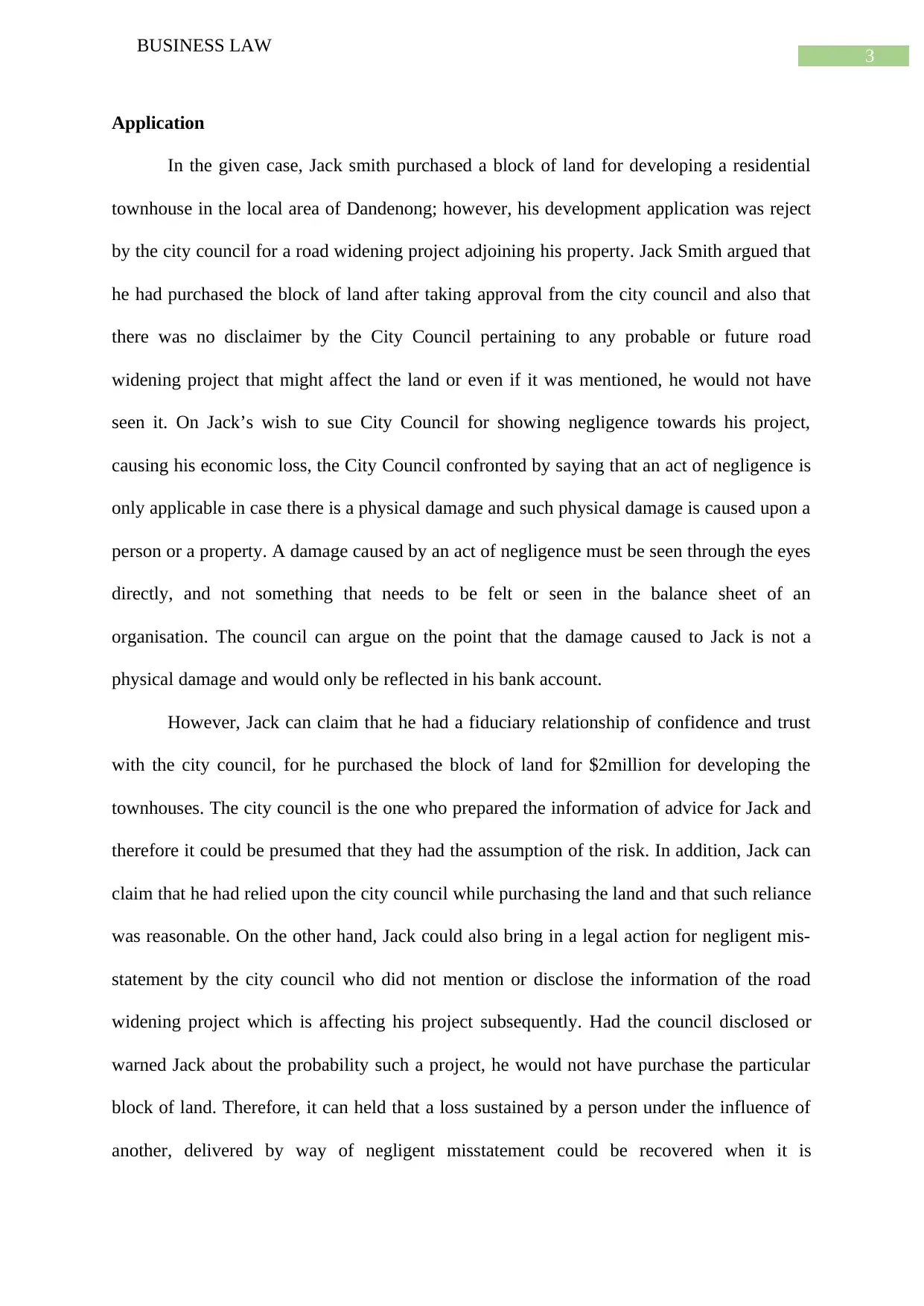
3
BUSINESS LAW
Application
In the given case, Jack smith purchased a block of land for developing a residential
townhouse in the local area of Dandenong; however, his development application was reject
by the city council for a road widening project adjoining his property. Jack Smith argued that
he had purchased the block of land after taking approval from the city council and also that
there was no disclaimer by the City Council pertaining to any probable or future road
widening project that might affect the land or even if it was mentioned, he would not have
seen it. On Jack’s wish to sue City Council for showing negligence towards his project,
causing his economic loss, the City Council confronted by saying that an act of negligence is
only applicable in case there is a physical damage and such physical damage is caused upon a
person or a property. A damage caused by an act of negligence must be seen through the eyes
directly, and not something that needs to be felt or seen in the balance sheet of an
organisation. The council can argue on the point that the damage caused to Jack is not a
physical damage and would only be reflected in his bank account.
However, Jack can claim that he had a fiduciary relationship of confidence and trust
with the city council, for he purchased the block of land for $2million for developing the
townhouses. The city council is the one who prepared the information of advice for Jack and
therefore it could be presumed that they had the assumption of the risk. In addition, Jack can
claim that he had relied upon the city council while purchasing the land and that such reliance
was reasonable. On the other hand, Jack could also bring in a legal action for negligent mis-
statement by the city council who did not mention or disclose the information of the road
widening project which is affecting his project subsequently. Had the council disclosed or
warned Jack about the probability such a project, he would not have purchase the particular
block of land. Therefore, it can held that a loss sustained by a person under the influence of
another, delivered by way of negligent misstatement could be recovered when it is
BUSINESS LAW
Application
In the given case, Jack smith purchased a block of land for developing a residential
townhouse in the local area of Dandenong; however, his development application was reject
by the city council for a road widening project adjoining his property. Jack Smith argued that
he had purchased the block of land after taking approval from the city council and also that
there was no disclaimer by the City Council pertaining to any probable or future road
widening project that might affect the land or even if it was mentioned, he would not have
seen it. On Jack’s wish to sue City Council for showing negligence towards his project,
causing his economic loss, the City Council confronted by saying that an act of negligence is
only applicable in case there is a physical damage and such physical damage is caused upon a
person or a property. A damage caused by an act of negligence must be seen through the eyes
directly, and not something that needs to be felt or seen in the balance sheet of an
organisation. The council can argue on the point that the damage caused to Jack is not a
physical damage and would only be reflected in his bank account.
However, Jack can claim that he had a fiduciary relationship of confidence and trust
with the city council, for he purchased the block of land for $2million for developing the
townhouses. The city council is the one who prepared the information of advice for Jack and
therefore it could be presumed that they had the assumption of the risk. In addition, Jack can
claim that he had relied upon the city council while purchasing the land and that such reliance
was reasonable. On the other hand, Jack could also bring in a legal action for negligent mis-
statement by the city council who did not mention or disclose the information of the road
widening project which is affecting his project subsequently. Had the council disclosed or
warned Jack about the probability such a project, he would not have purchase the particular
block of land. Therefore, it can held that a loss sustained by a person under the influence of
another, delivered by way of negligent misstatement could be recovered when it is
Paraphrase This Document
Need a fresh take? Get an instant paraphrase of this document with our AI Paraphraser
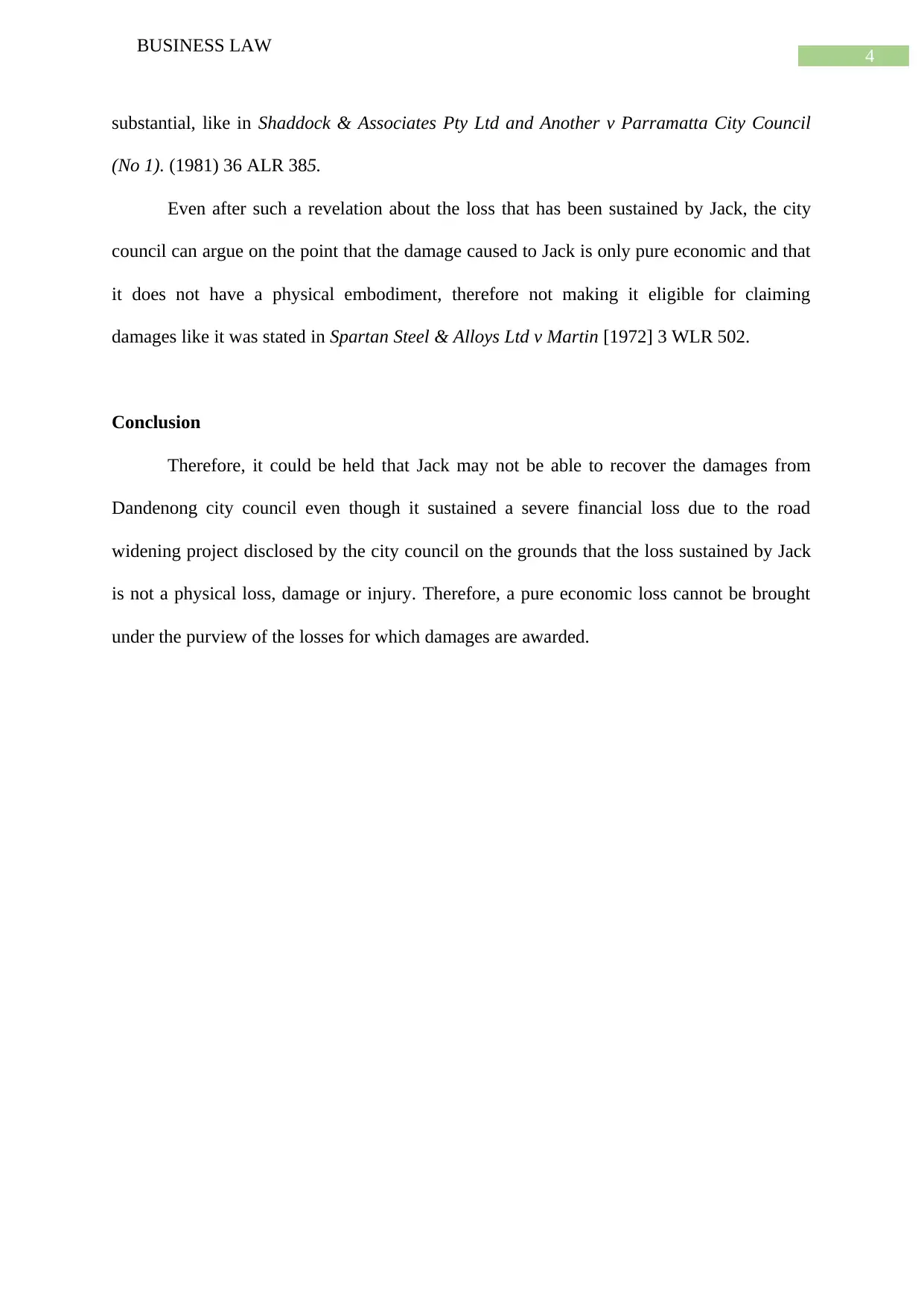
4
BUSINESS LAW
substantial, like in Shaddock & Associates Pty Ltd and Another v Parramatta City Council
(No 1). (1981) 36 ALR 385.
Even after such a revelation about the loss that has been sustained by Jack, the city
council can argue on the point that the damage caused to Jack is only pure economic and that
it does not have a physical embodiment, therefore not making it eligible for claiming
damages like it was stated in Spartan Steel & Alloys Ltd v Martin [1972] 3 WLR 502.
Conclusion
Therefore, it could be held that Jack may not be able to recover the damages from
Dandenong city council even though it sustained a severe financial loss due to the road
widening project disclosed by the city council on the grounds that the loss sustained by Jack
is not a physical loss, damage or injury. Therefore, a pure economic loss cannot be brought
under the purview of the losses for which damages are awarded.
BUSINESS LAW
substantial, like in Shaddock & Associates Pty Ltd and Another v Parramatta City Council
(No 1). (1981) 36 ALR 385.
Even after such a revelation about the loss that has been sustained by Jack, the city
council can argue on the point that the damage caused to Jack is only pure economic and that
it does not have a physical embodiment, therefore not making it eligible for claiming
damages like it was stated in Spartan Steel & Alloys Ltd v Martin [1972] 3 WLR 502.
Conclusion
Therefore, it could be held that Jack may not be able to recover the damages from
Dandenong city council even though it sustained a severe financial loss due to the road
widening project disclosed by the city council on the grounds that the loss sustained by Jack
is not a physical loss, damage or injury. Therefore, a pure economic loss cannot be brought
under the purview of the losses for which damages are awarded.
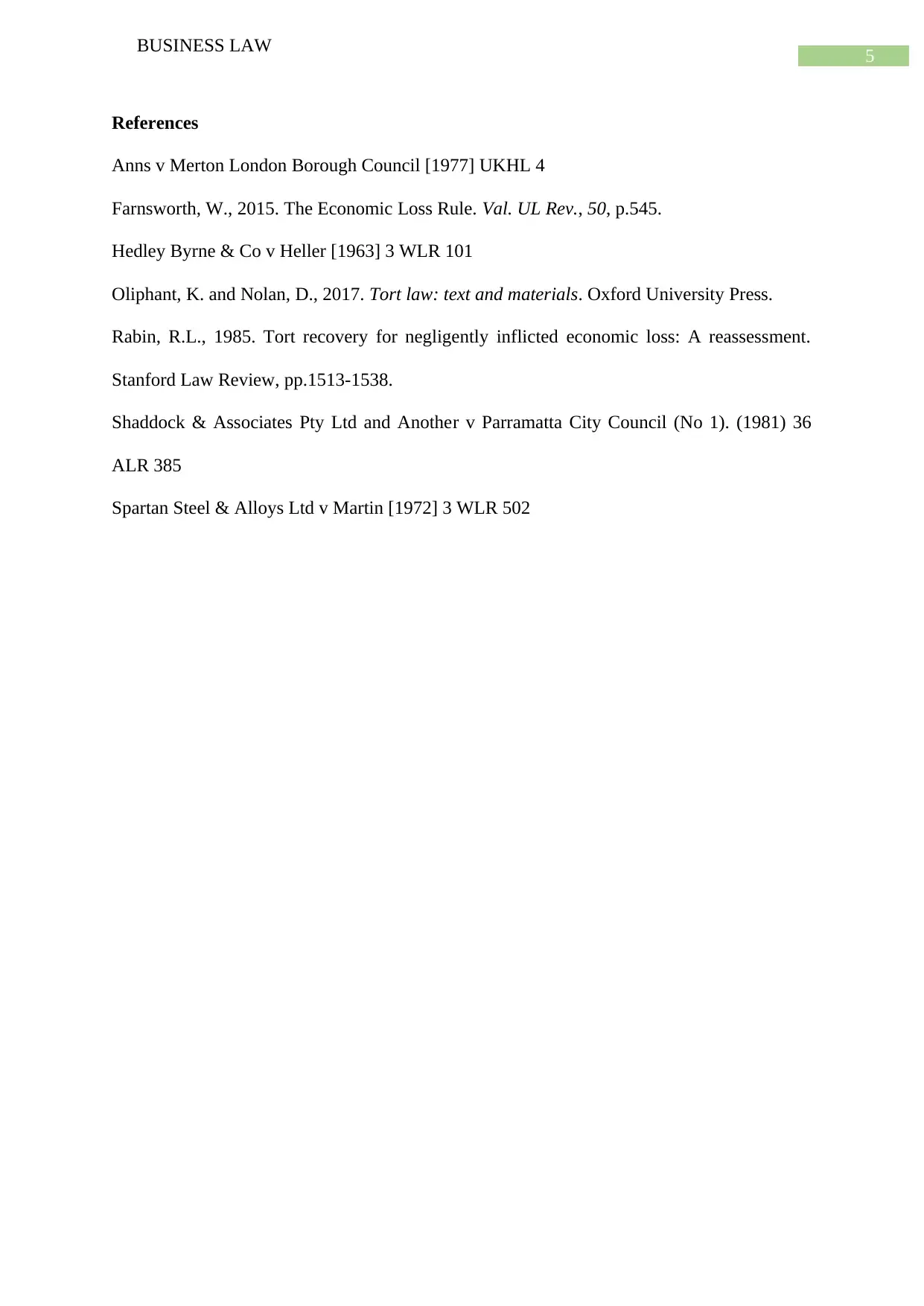
5
BUSINESS LAW
References
Anns v Merton London Borough Council [1977] UKHL 4
Farnsworth, W., 2015. The Economic Loss Rule. Val. UL Rev., 50, p.545.
Hedley Byrne & Co v Heller [1963] 3 WLR 101
Oliphant, K. and Nolan, D., 2017. Tort law: text and materials. Oxford University Press.
Rabin, R.L., 1985. Tort recovery for negligently inflicted economic loss: A reassessment.
Stanford Law Review, pp.1513-1538.
Shaddock & Associates Pty Ltd and Another v Parramatta City Council (No 1). (1981) 36
ALR 385
Spartan Steel & Alloys Ltd v Martin [1972] 3 WLR 502
BUSINESS LAW
References
Anns v Merton London Borough Council [1977] UKHL 4
Farnsworth, W., 2015. The Economic Loss Rule. Val. UL Rev., 50, p.545.
Hedley Byrne & Co v Heller [1963] 3 WLR 101
Oliphant, K. and Nolan, D., 2017. Tort law: text and materials. Oxford University Press.
Rabin, R.L., 1985. Tort recovery for negligently inflicted economic loss: A reassessment.
Stanford Law Review, pp.1513-1538.
Shaddock & Associates Pty Ltd and Another v Parramatta City Council (No 1). (1981) 36
ALR 385
Spartan Steel & Alloys Ltd v Martin [1972] 3 WLR 502
⊘ This is a preview!⊘
Do you want full access?
Subscribe today to unlock all pages.

Trusted by 1+ million students worldwide
1 out of 6
Related Documents
Your All-in-One AI-Powered Toolkit for Academic Success.
+13062052269
info@desklib.com
Available 24*7 on WhatsApp / Email
![[object Object]](/_next/static/media/star-bottom.7253800d.svg)
Unlock your academic potential
Copyright © 2020–2025 A2Z Services. All Rights Reserved. Developed and managed by ZUCOL.





